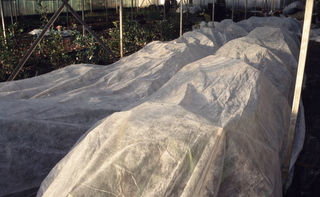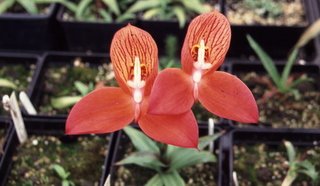|
How To Grow Disas Our Way
After growing lettuce for supermarkets for 25 years in our glasshouses, we have changed direction. The Orchids which were our hobby are now our passion, growing, showing and breeding South African Disa Orchids from an original start of 4 plants and then buying a small collection in 1994.
We have divided, propagated and sown seed to multiply up our plant numbers to become the largest growers of Disa Orchids in the UK with over 10,000 plants, all now grown and raised in Yorkshire.
Disas are terrestrial Orchids which are a native of Table Mountain in South Africa, growing in streams and seepage areas with their roots in water, so we grow all our Disas wet, standing in black trays filled with rainwater to keep their roots wet. Even in winter the plants are still kept damp.
We have experimented with many different growing media, the most successful being 60 % peat an 40% Perlite, which is our standard mix.
We have also had limited success in Sphagnum Moss and in Vermiculite although they do have their problems!
We are continuing to experiment with different media and will keep you updated, our worst failures were with rock wool and ordinary potting composts.
Feeding with very dilute high nitrogen, low phosphorous fertilisers is done in spring to help develop new growths and again in early autumn to enhance the tuber growth. Alternatively a dilute seaweed fertiliser can be given, into the trays.
The Disas need some frost protection either with a heater, optimum night temperature 2 o C to 8 o C or covered with thick grade Horticultural Fleece, which can be lifted during the day to maximise light.

The majority of our plants are multipolied by vegetative division, done in autumn if the plants are large enough, or alternatively left until March, when the divisions seem to establish better.
The old plant is removed from the pot, lowered into a bucket of water, and the compost loosened. The plant is then placed on a bench and the new growths gently teased from the mother plants, with roots attached, then lightly potted up, tapping the compost around the plant, do not press down the growing media.
- Large plants go into 11 cm pots.
- Small Plants go into 9 cm pots.
In Summer parent plants are selected for our seed programme, the pollinia from one parent is placed onto the stigma of the other parent, and duly labelled.
After approximately4- 6 weeks the fertilised flower capsule should have swollen with seed and be ripe. Peat mix is wet up in pots and then ripe seed is dusted onto the surface, the pots are stood in rainwater in a cool place for germination to take place.
Protocorms should eventually form and later seedlings emerge. This is the old fashioned way of seed sowing, taking up to 5 years between sowing and flowering, but we find the end result is stronger, sturdier plants.
In 2006 we registered a new Disa Hilda Parkinson with the R.H.S. and in 2007 a further 8 Disas were registered. We hope to have some of these plants available for sale in 2010.
During summer maximum ventilation should be given. Some shading should be applied, either green mesh shading or spray shade in a greenhouse, or if growing in the house a blind of net curtains drawing to allow bright light but not scorching sun. Keep cool if possible.
The flowering season is from April through to august depending on varieties. Flowers should last 4 – 6 weeks and often longer if kept cool.
 Disas are usually not troubled by many pests, keep a lookout for Aphids on the flower buds and spray with an insecticide if necessary. Slugs and snails can damage the leavesand stems, but are not usually a great problem. Disas are usually not troubled by many pests, keep a lookout for Aphids on the flower buds and spray with an insecticide if necessary. Slugs and snails can damage the leavesand stems, but are not usually a great problem.
Reports have been made of Vine Weevil damage, if the medium is kept wet enough this should not be a problem. If necessary treat with biological control.
Fungal diseases are best prevented rather than treated. Change water regularly. Remove old foliage and damaged leaves. Keep good air movement and ventilation and do not keep too warm during the winter. Spray with fungicide if rots appear.
Our basic principles are, keep the growing methods simple, do not over-complicate and enjoy the brilliant coloured flowers and their outstanding beauty.
|